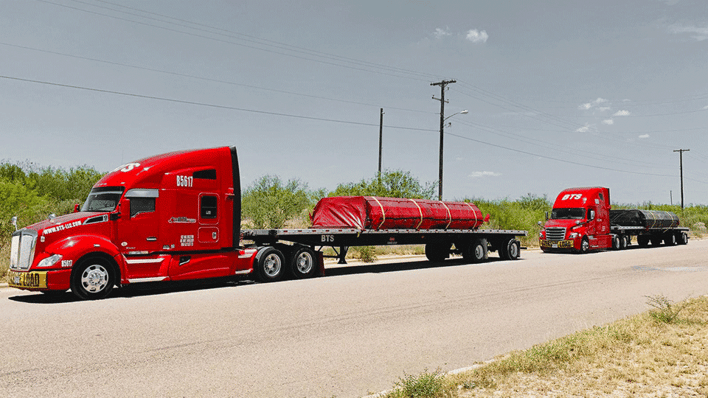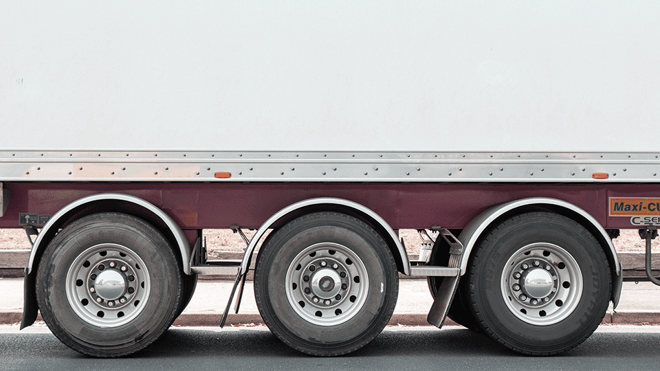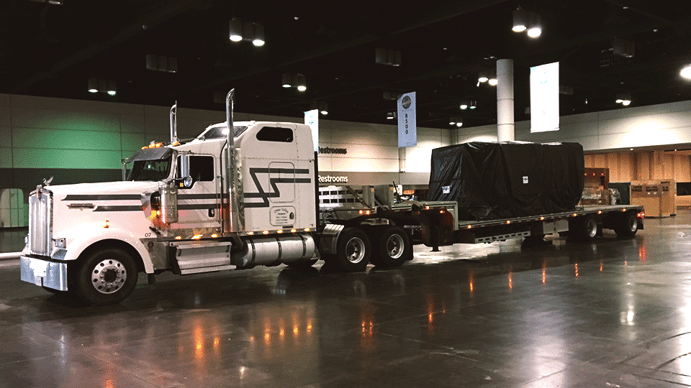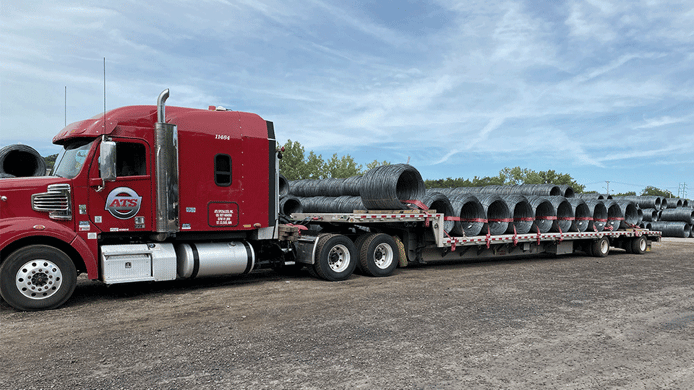As a central segment of your supply chain, your transportation processes and partnerships should never go unnourished.
Fill this portion of your logistical operations with quality and accountability, urgency and respect. Optimize your processes alongside carriers that have earned your trust.
In time, as these relationships grow and your business’ supply chain flourishes, delivering on each customer commitment you extend will become simple; causing little stress and fewer mishaps.
That said, the flatbed transportation marketplace — a market fully-saturated with companies of all shapes and sizes — offers no selection guidelines for shippers to lean on when choosing carriers. Instead, shippers — especially those with little experience in this arena — are left without the insights necessary for getting these crucial decisions correct.
In the end, good companies like yours — that aspire only to meet consumer needs and positively contribute to global, area and local economic health — are left a singular route forward: trial and error.
When it comes to the transportation of your open-deck freight, trial and error simply won’t cut it.
Your business deserves better, your customers do too.
Going forward, let’s make sure that every flatbed carrier added to your network clearly and unequivocally fits. Achieving this end will take a well-rounded process for rooting out these companies from a seemingly endless pool of options. This article will serve to guide you onward, toward the greener pastures of flatbed transportation success.
Here at Anderson Trucking Service (ATS), our fleet of trucks and open-deck trailers have helped our Specialized division progressively rise through national flatbed-carrier rankings practically every year since 1955. During this time and through our experience, we’ve developed a firm understanding of the factors that make a shipper-carrier relationship work — including what shippers should prioritize when selecting a carrier.
Below, you’ll find these understandings put to paper. Use them as you continue your journey toward becoming the supplier that always delivers for your customers.
To select the absolute best-fit flatbed trucking company for your business, make sure to:
- Understand your current and future transportation needs
- Consider each carrier’s strengths, size and resources
- Varify each flatbed company’s safety practices/procedures
- Vet for technology usage and adoption
- Take history, longevity and financial security into account
#1: Understand Your Current and Future Transportation Needs
Every selection decision you make, and every partnership you enter, whether in the business world or out of it, is to accomplish one (or both) of the following things:
- To fill a void; to meet a set of needs, wants or desires
- To save you from something; to prevent the unnecessary loss of money, time or other finite resources
Although there are certainly more micro-factors driving each decision (biases, past experience, social and economic status, etc.) the fact remains: achieving a desired outcome is what every purchaser is looking for in the end.
Selecting a flatbed transportation provider to use is no different.
While every company you’ll come across on this journey has different strengths and weaknesses to consider, failing to comprehensively understand your needs will hinder your ability to weigh them against each prospect.

For this reason, it’s important that you take the time to strategically catalog and (where necessary) prioritize your company’s logistical requirements. But where should you start?
Although processes tend to change from one business to the next and where you begin making these discernments is of little consequence, here are the foundational factors to consider before searching for a flatbed carrier:
1. Volume Considerations
Projected volumes are one of the first categories you’ll want to address before sourcing for new flatbed companies. Knowing your numbers and the frequency with which you send freight is crucial to matching these needs with the capabilities of prospective carriers.
An intimate understanding of your volume projections well into the future will help you qualify carriers based on their size, capabilities and areas of influence. Without this knowledge, many shippers enter vetting conversations blind to their true requirements — sending these relationships off course before they even begin.
Here are some volume-specific questions to ask yourself and solve for:
- At what frequency will I need flatbed truck capacity?
- Is it possible that these projected volumes (whether quarterly, monthly or weekly) could change in the foreseeable future?
- Is having access to flex/surge capacity something that would be valuable to my business.
- What kind of loading procedures will I utilize to keep freight moving efficiently? (live-loading, drop trailers or both?)
Note down your answers to these, and questions like these, and be sure to communicate them with each prospective carrier, complete with expected tender-acceptance rates.
2. Locational, Lane-Specific Considerations
Another category you’ll want to focus on here is your supply chain’s destination, origin and length of haul requirements. Comprehensively understanding these requirements and the frequency with which a carrier would need to be soliciting each, will do you great favors long term.
Since flatbed trucking companies, on the whole, hold individualized sets of capabilities and preferences as it relates to regions, lanes and length of hauls you’ll need to choose carefully.
Some questions to consider when rooting out your needs are:
- What are my length of haul requirements?
- How frequently will my open-deck load travel. . .
- short-haul distances? (<250 miles)
- mid-haul distances? (251-500 miles)
- long-haul distances? (500-1,200 miles)
- extended long-haul distances? (1,200+ miles)
- What are my origin and destination locational needs?
-
- Do I ship mostly in, out of, around and to the. . .
- Midwest?
- Northwest?
- Southwest?
- Northeast?
- Southeast?
- Do I require nationwide coverage?
- Do I ship mostly in, out of, around and to the. . .
Whatever the case may be, it’s imperative to adequately understand and communicate your coverage-area needs. Formulate your vetting procedures around these understandings to ensure that each flatbed carrier can service these requirements.
3. Equipment-Related Considerations
Open-deck transportation, more than many other service types, is brimming with intricacies and options to consider. To find the best open-deck carrier for your company, however, will mean making many of these discernments pre-emptively.

No one knows your freight as intimately as you do. As such, it’s up to you to ensure that your flatbed carriers of choice have the assets and resources to move it safely and securely.
Here are some things to consider as far as transportation equipment is concerned:
- What kind of trailers will I need access to?
- What kind of trailers am I capable of loading/offloading?
- Flatbeds?
- Step-decks?
- Double-drops?
- low-pro step-decks?
- RGNs?
- etc.
- Dimensionally speaking, which trailer types will fit my freight?
- 48 and 53-foot flatbeds?
- 53-foot step-decks?
- Conestoga trailers?
- Lowboy trailers?
- Double-drop trailers?
- Etc.
- What kind of “extra” equipment will my open-deck loads require?
- Will tarping come into play?
- Do I plan on “gift wrapping” cargo? (will require additional tarps)
- Does my cargo have sharp edges that will require padding?
- Should securement be done with straps or chains? Will both work?
- How much dunnage do I have on hand at a given time? Will inbound trucks need to supply some?
Not every flatbed/specialized carrier owns each of these assets or has them in bulk. For this reason, it’s important that you enter your vetting processes with the correct information and understandings.
Once you’ve completed the hard work of inventorying each of your flatbed transportation requirements and have this information to guide you through your vetting discussions, the easy part begins: Weighing the capabilities of each flatbed carrier against your company’s capacity needs, values, concerns and procedural requirements.
#2 Consider Each Carrier’s Strengths, Size and Resources
Some of the first pieces of information you’ll want to gather from prospective trucking companies are those related to their areas of strength, overall size and pool of resources.
By this point, you should firmly understand what you’re looking for, so be unwavering here. Ensure that this flatbed carrier has the wherewithal to positively contribute to your supply chain by, first and foremost, inquiring about its strengths.
Why Do a Flatbed Company’s Strengths, Size and Resources Matter?
As a general rule, resulting from the nature of this business, asset-based flatbed companies have specific areas, lanes, regions and distances in which they’re strongest.
Defined by their corporate strategy and operational proficiencies, individual flatbed trucking companies are great at doing some things and less formidable at others.
Some companies, for example, (based on the location of their trucks, trailer yards and customer base) prefer to stay within a certain region of the U.S., opting to forgo shipments to destinations where finding backhaul freight may challenge them.
Other, larger companies service wide areas of the country, leaning on well-formed customer relationships and extensive infrastructure.
You’ll want to understand these operational preferences and strengths; which areas they frequent, the distances they typically haul and what they steer clear of.
Transportation resources on the other hand, such as truck and trailer count, will change to match their size. If you’re a high-volume shipper (moving multiple shipments to various destinations per week) this will be an important consideration.
Luckily, flatbed carriers are acutely aware of their strengths, weaknesses and the resources they’re capable of offering you.
Ask about them.
Here’s a list of questions to get you started:
- What is your company’s core strengths?
- What type of cargo do you move most frequently?
- What type of freight are you not good at moving?
- What are your preferred lanes, regions and distances?
- Where are your assets located?
- What is your truck-to-trailer ratio?
- What percentage of your fleet is specialized (e.i. Step-decks, lowboys, RGNs, etc.)?
#3: Verify Every Flatbed Company’s Safety Practices/Procedures
The value of having a network brimming with safe flatbed carriers is hard to quantify.
In an industry as heavily regulated and naturally dangerous as transportation, well-rounded safety practices and procedures should be an inseparable piece of every flatbed trucking company. Without having processes in place to keep roadways, truck drivers and the motoring public safe, no trucking company lasts long.
And, in the creation of your transportation network, shoddy safety protocols should never be accepted. While the majority of trucking companies have this segment of their business worked out — complete with an in-house safety department and regular trainings/seminars — some don’t. Make sure to steer clear of unsafe carriers.

From a macro level, carriers that make safety a priority with every load, state as much on their websites and marketing materials. But these shouldn’t be your only points of reference for this information.
Instead, we encourage you to reference third-party sources for this data as well. The Federal Motor Carrier Safety Administration’s (FMCSA) website is a great place to start.
Within its pages, the FMCSA’s site gives shippers the opportunity to examine a trucking carrier’s safety-related data by pulling a number of different reports using that company’s DOT Number, MX/MC Number or Name.
Safety report options include requesting a company snapshot, a company safety profile (for a fee) and/or pulling carrier-safety metrics from the FMCSA’s Safety Measurement System.
These reports will give you a ton of historical safety data for each company including:
- Inspection results
- Crash data
- Out-of-service summaries
- Safety ratings
- Company size
Use the information gathered in these reports to compare flatbed companies against each other and weed out those with less-than-pristine records.
Additionally, the transportation marketplace is full of safety programs for carriers to participate in. Some safety-rated programs great companies take part in are:
-
Customs-Trade Partnership Against Terrorism (C-TPAT)
A program enacted by the U.S. Customs and Border Protection office in 2001, C-TPAT is designed to create partnerships between carriers, brokers and other members of the U.S. trade community. Members of C-TPAT work alongside Customs and Border Protection to safeguard their supply chains by identifying security gaps and implementing specific measures aimed at preventing instances of terrorism and securing cargo at the highest possible level.
C-TPAT is free to join and gives members repeat training/updates on security best practices as well as several benefits.
Related Content: What is The Customs-Trade Partnership Against Terrorism (CTPAT)?
-
SmartWay
SmartWay is a program, developed and managed by the Environmental Protection Agency (EPA) that helps companies in the transportation industry improve their supply chain efficiency and environmental impact.
Companies that participate in SmartWay programs enter a partnership with the EPA where they work to develop tactics for reducing their environmental footprint. Among other things, SmartWay carriers easily track and document their fuel consumption and emissions data and are given access to top-of-the-line fuel-saving technologies.
Actively participating in these, and programs like these, is a great way for carriers to ensure their customer's industry-leading service. Take this into account when vetting your next flatbed company.
Related Content: What is a SmartWay Certification?
Finally, when it comes to the safety of your cargo and your reputation never beat around the bush. You’ll want to quiz each potential flatbed provider about their safety culture head on.
Here are some questions to get you started:
- How do safety ratings play into your drive hiring processes?
- What is the average age of the equipment in your fleet?
- Do you have a driver class system to ensure only the most qualified drivers are on my load?
- What steps do you take to ensure the safe and secure transportation of your customer’s freight?

#4: Vet For Technology Usage and Adoption
As day-to-day life becomes increasingly intertwined with technology, and doing things “analog” continues its creep toward oblivion, much of this change has spilled into the transportation world as well.
Today, flatbed trucking companies — and all transportation companies, for that matter — have access to a wide variety of technological resources. And, though things like trailer tracking devices and ELD software represent a significant financial investment for carriers (especially those with larger fleets), they’re also well worth it.
With the assistance of GPS tracking technology and application programming interfaces, communicating timely, shipment-specific information has never been easier for flatbed carriers to do.
That said, not every one of them is capable and/or willing to utilize the latest, greatest technologies. You see, as the world changes around them, some carriers are resistant to it, opting instead to stand by the ways of old and missing opportunities to better-service customers.
As you strive to create a solvent and efficient flatbed transportation network, make sure to prioritize technology usage in your search. Digital tools will continue to creep into the transportation world and, if your carrier is resistant to them now, you may be at a disadvantage later on.
Make sure to ask about this aspect of each carrier’s business by posing questions like:
- What load-tracking technologies do you utilize? What are their features?
- What technologies do you use to give you real-time transportation market insights?
- What is your process for keeping customers and tracking technologies up to date?
- Do you offer a customer portal?
Depending on the way each carrier responds to these questions, you should walk away with a keen understanding of where they stand in the digital age. Are they on the cutting edge, hungry to improve their processes by leveraging technology? Or are they resistant to change, hesitant to due away with their old processes in exchange for the new?
When selecting a flatbed trucking company, try to choose those that align with the former.
#5: Take History, Longevity And Financial Standing Into Account
This last point is perhaps most important. You see, history is not kind to unreliable flatbed trucking companies; carriers that don’t follow through, price gouge, boast unsafe practices and fail their customers.
In fact, the companies cut of this cloth rarely stick around long.
Use history and longevity as your guide during your search for flatbed trucking carriers. There are parts of this business, unforeseen intricacies, that only experience can teach you to navigate.
The last thing you deserve is to choose a carrier that — due to infrastructure, overhead, financial or a variety of other issues — can’t get the job done for you. To avoid these issues, and feeling stranded when a flatbed provider ghosts your business or closes up shop entirely, steer clear of “young” carriers.
Although there isn’t a “sweet spot” where longevity is concerned, we’d recommend that you avoid carriers that have been in the marketplace for under two years.
In doing so, you’ll avoid many of the mishaps associated with inexperience in an unforgivable industry.
Finding longevity information on each of the carriers you use won’t take much effort; most of them openly share historical timelines on their websites.
That said, here are some questions you can bring to vetting conversations — just in case:
- How long has your company been in operation?
- How many locations do you have?
- Can you give me an estimated number of employees?
- How long have you been moving my kind of freight?
- What has experience taught you are the most common issues on these types of loads?

Beyond simply how many years a flatbed company has been in business, it’s even more important to consider every carrier’s financial health. You see, the vast majority of flatbed carriers (around 80 percent) operate fleets with six trucks or fewer.
For companies of this size, the realities of the trucking industry — its volatility and high competition — often hit harder.
As a result, a large segment of the transportation marketplace is heavily leveraged with debt, struggling to make ends meet in a cutthroat industry. Over the years, we’ve seen plenty of carriers go out of business due to their financial realities.
These are the types of companies you’ll want to avoid. And, while poor financial standing is most common among smaller carriers, some larger companies struggle here as well. For this reason, make sure to vet every company on its finances.
If you take nothing else away from this section, we hope it’s this: history, in the transportation industry, often equates to stability.
When it comes to moving your flatbed freight — cargo that is essential to your business — you deserve stability and experience in your corner.
Make Sure They “Check” All The Boxes!
Here at ATS, we truly understand the predicament you’re in. Without the right providers in your corner — providers that value your business and strive to help you meet your goals — moving open-deck freight can feel like a harrowing undertaking.
It doesn’t have to be difficult to find great flatbed companies though.
Due diligence is best done through communication. No matter how much time you spend scouring company reviews, reading case studies and browsing their web pages, eventually, you’ll need to lean in and ask the tough questions.
To help you do so, we’ve compiled a Flatbed Carrier Selection Checklist. This 36-question checklist was created to guide you through your vetting conversations. And, based on how they score, give you an idea as to how well each carrier will fit your needs.
Download it for free today, and wave goodbye to unreliable transportation partnerships going forward.
Finally, if you have any questions about ATS’ flatbed transportation services, or what type of companies we fit best, check out this video where we’ll give you these crucial insights.




